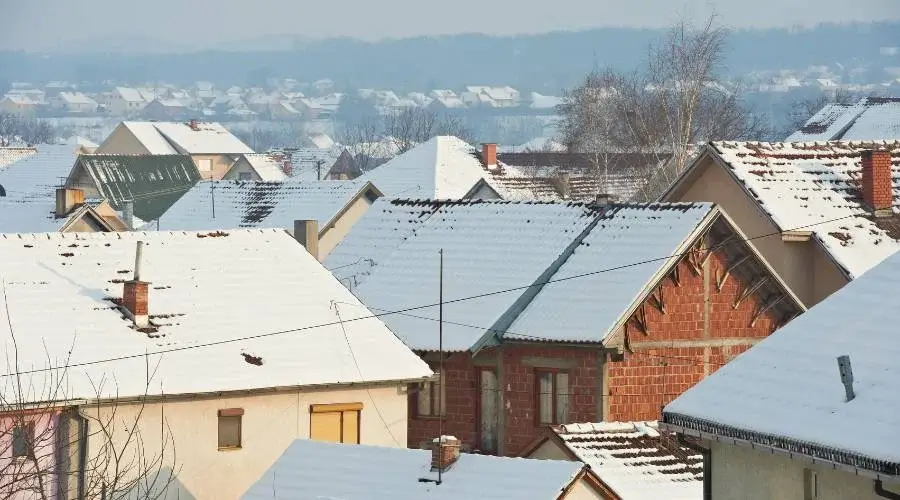Winterizing your home is crucial, and paying attention to your roof is essential. Follow this comprehensive guide to prepare your roof for winter, ensuring it remains resilient against cold weather, snow, and ice. Reach out to Wayne NJ Roofing right away. If we detect any issues causing a leaking roof or structural damage, we’ll provide you with a free estimate promptly.
Roof Inspection and Maintenance
Initiate your winter roof preparations with a thorough inspection. Ascend a ladder and meticulously examine your roof’s condition, checking for missing or damaged shingles, water damage, and areas requiring resealing. Promptly address any identified issues to prevent escalation during the winter.
Gutter Cleaning
Safeguard your home against potential leaks and ice dams by prioritizing regular gutter maintenance. Be proactive in reducing the likelihood of damage by ensuring that your gutters remain debris-free. Clearing leaves and blockages from gutters and downspouts is a simple yet effective measure.
This provides efficient water flow, allowing melted snow and ice to drain smoothly from the roof. Investing a bit of time in this preventative measure protects your property and contributes to your home’s overall well-being. A well-maintained gutter system reflects your commitment to a safe and secure living environment.
Branch Trimming
Pruning overhanging branches is crucial in fortifying your property against the harsh effects of winter weather. Concentrating on branches near the roofline reduces the risk of breakage caused by heavy snow or ice accumulation.
This preventive measure not only safeguards your roof from potential damage but also enhances the overall safety of your surroundings. Branch trimming is a proactive approach to maintaining the structural integrity of your home, preventing unforeseen accidents, and promoting the longevity of your roof. Prioritize this task to ensure a secure and resilient shelter throughout the winter months—your roof.
Leak Sealing
Address potential sources of leaks identified during the roof inspection. Replace damaged shingles and seal gaps and cracks to prevent water damage and leaks during the winter.
Attic Insulation
Elevate your winter roof preparation by strongly emphasizing adequate attic insulation. The importance of a well-insulated attic cannot be stressed because it is essential to maintaining consistent indoor temperatures and thwarting the formation of ice dams. A properly insulated attic contributes to a more comfortable living environment and enhances energy efficiency. Preventing heat leakage through the roof lowers energy use and lessens the possibility of ice dams, which may jeopardize your roof’s structural integrity.
Attic insulation is a foundational measure in fortifying your home against the challenges of winter weather, ensuring a cozy and resilient interior.
Ventilation Check
Ensure proper ventilation to prevent Moisture accumulation in the attic, which may lead to mold and structural damage. Confirm the functionality of the ventilation system, clearing vents of any obstruction and regularly cleaning and maintaining them.
Ice Dam Prevention
Guard against ice dams by maintaining a well-insulated attic. Consider installing ice and water shields under your shingles to counter the effects of melted snow refreezing on colder eaves, potentially causing leaks.
Roof Snow Removal
After substantial snowfall, safeguard your roof from structural damage and ice dams by carefully removing excess snow using a roof rake. Exercise caution to prevent shingle damage during the removal process.
Snow-Resistant Roof Styles for the Winter Months
As the snowflakes begin to fall and winter blankets the landscape, homeowners in Wayne, where heavy snowfall is expected, must be proactive in choosing roof styles that can effectively handle the weight of accumulated snow.
Opting for roofs that withstand heavy loads is essential in regions with substantial snowfall. One such robust design is the steep-pitched roof, known for its ability to shed snow efficiently. Its steep angle prevents the snow from accumulating,
encouraging a natural slide-off. Additionally, gable roofs with triangular shapes provide another snow-shedding advantage, minimizing the risk of excessive snow buildup. It’s crucial to consider these specialized roof styles to ensure your home’s aesthetic appeal and structural integrity during the winter months in Wayne.
1. The Gable Roof
Renowned for its ability to handle heavy snow loads, the gable roof has steep slopes that encourage efficient snow shedding. The pronounced incline minimizes the risk of excessive snow accumulation, preventing the potential strain on the structure. The triangular shape contributes to its snow-shedding efficiency and offers a classic, timeless aesthetic appeal.
Homeowners in Wayne can benefit from the gable roof’s functionality during winter, as its design naturally facilitates the controlled descent of snow, safeguarding the home’s structural integrity. This roof style is a practical choice and gives it a hint of elegant architecture, making it the perfect option for areas vulnerable to substantial snowfall.
2. The Shed Roof
Esteemed for its ability to withstand heavy snow loads, the gable roof has steep slopes promoting efficient snow shedding. This pronounced incline minimizes the risk of excessive snow accumulation, averting potential structural strain. Its triangular shape enhances both snow-shedding efficiency and offers a timeless aesthetic appeal.
Wayne homeowners can rely on the gable roof’s functionality in winter, as its design naturally guides snow descent, preserving the home’s structural integrity. Beyond its practicality, this roof style introduces architectural elegance, making it an ideal solution for regions susceptible to substantial snowfall.
3. The Hip Roof
Slopes on all sides distribute snow evenly, reducing the risk of heavy snow piling up. This design is visually appealing and provides a unique appearance.
4. The Gambrel Roof
Two slopes on each side allow snow to shed quickly, adding rustic charm to your home.
5. The Flat Roof with Reinforcements
Adequately designed and reinforced flat roofs can handle heavy snow loads, ideal for contemporary architectural styles.
6. The Butterfly Roof
A strikingly modern design that encourages snow to slide off, adding avant-garde beauty to your home.
7. The Steep-Pitched Roof
Steeply pitched roofs encourage snow to slide off and offer extra attic space, making them both functional and attractive.
winterizing your home demands a holistic approach with meticulous attention to your roof. The comprehensive guide emphasizes key steps to fortify defending your roof from the harshness of winter weather, such as cold temperatures, snow, and ice. Initiating a thorough roof inspection, addressing issues promptly, and ensuring clean gutters are fundamental steps in maintaining the resilience of your roof. Trimming overhanging branches, sealing potential leaks, and prioritizing attic insulation further contribute to the longevity and efficiency of your roof.
It is impossible to exaggerate how crucial adequate ventilation is for preventing moisture accumulation and subsequent harm.
The guide also highlights snow-resistant roof styles, such as the gable roof, shed roof, hip roof, gambrel roof, flat roof with reinforcements, butterfly roof, and steep-pitched roof. These designs provide structural stability by efficiently clearing snow and add aesthetic appeal to your home, ensuring it stands out in a winter wonderland.





